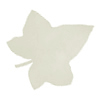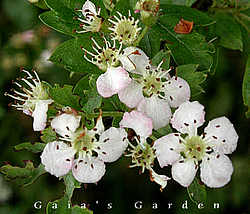


|
A
decidious, thorny bush / tree which can grow to
about 8m (25ft) with twisty, tangled branches and
dense foliage and sharp thorns. The small leaves
have three or more bulbous lobes with deep indentations
between them and serrated-shaped edges. Sprays of
whitish 5-petalled blossoms change into clusters
of red berries by autumn. The flowers generally
bloom in December and May, with a heady fragrance,
but if the weather is frosty it flowers when hard
weather is over ["Ne'er cast a clout, til May
is out" - May being the folkname for Hawthorn] Hawthorn is a valuable medicinal herb and was a symbol of hope in the Middle Ages, when it was taken for many ailments. Often described as "food for the heart" Hawthorn is now used by Western Herbalists for heart and circulatory ailments, and has been used to remedy angina, heart arrythmias and high blood pressure as it is known to increase blood flow to heart muscles and restore normal heart beat. This current use stems from an Irish Physician who started using it successfully for such conditions towards the end of the 19th Century. Before then it was traditionally used in Europe to remedy kidney stones, bladder stones and as a diuretic. As is so often the case in Nature, the Hawthorn provides a remedy for those who fall victim to its thorns. Culpeper noted "If cloths or sponges be wet in the distilled water, and applied to any place wherein thorns and splinters, of the like, do abide in the flesh, it will notably draw them forth.." In
England the young leaves and berries of the Hawthorn
used to be known as 'bread and cheese' [nothing
to do with the taste - just in the sense that it
was considered basic foodstuff]. The young leaves
actually have a rather nutty taste, and the leaves
and flowers have long been used to make a herbal
cuppa long before the black tea we all know and
love came to this country. An infusion of the flowers
or leaves can be drunk to help restore blood pressure
and protect the heart and Austrian herbalist Maria
Treben recommends Hawthorn Tea for for headaches,
poor circulation, and lapses of memory. A decoction of the flowers, leaves or berries may also be used as a gargle for sore throats - and the berries apparently make a very good liquer brandy. "Places where Hawthorn grows profusely often seem to meditate earth energies and evoke a connection to ancient times." Elen Hawke
! Seek professional medical advice before using medicinally ! |
|

Gaia's Garden Library
Non Fiction Section : Gaia's Garden Herblore | Susun S. Weed Articles | Articles and Musings
Fiction Section : Short Stories & Prose| As Told
By Cat | Public Domain Texts| Poetry
Shop | Library | Gallery | Forum | Contact | Links








 There's
plenty of folklore concerning the Hawthorn - connections
with faeries, the underworld, May festivities -
and in Britain there was a very strong taboo against
bringing hawthorn into the house. In Celtic folklore
the Hawthorn was often referred to as the faerie
bush and it was considered bad luck to cut it for
fear of offending the faeries that inhabited it.
The exception was during May Day celebrations when
the collecting of sprigs and flowers was permitted.
There's
plenty of folklore concerning the Hawthorn - connections
with faeries, the underworld, May festivities -
and in Britain there was a very strong taboo against
bringing hawthorn into the house. In Celtic folklore
the Hawthorn was often referred to as the faerie
bush and it was considered bad luck to cut it for
fear of offending the faeries that inhabited it.
The exception was during May Day celebrations when
the collecting of sprigs and flowers was permitted.